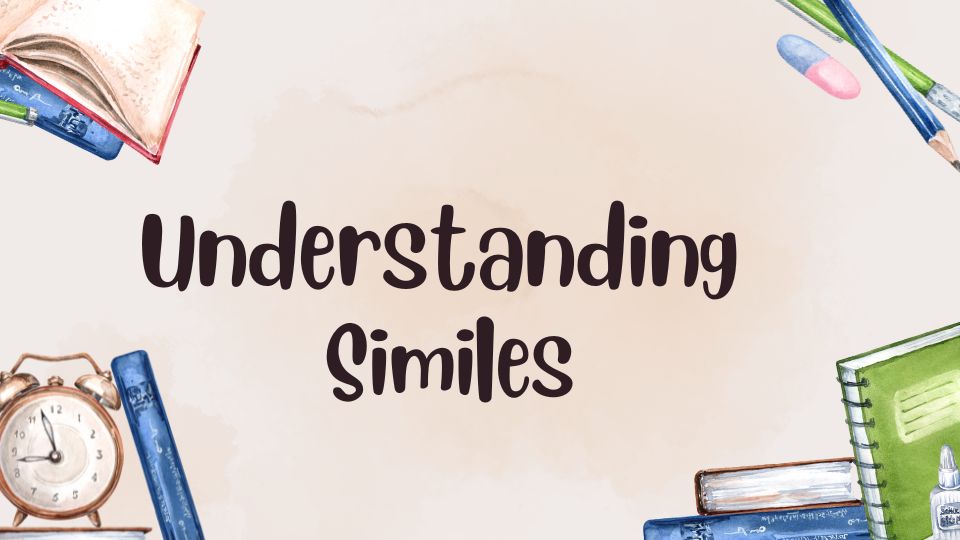Simile adds colorful images to our language. In this section we will learn that what similes are, examples, types and basic difference with metaphors.
Understanding Simile
Simile compares different things using “like” or “as,” creating strong images and feelings. For example, “Her smile was like sunshine” shows warmth and happiness. They turn simple descriptions into interesting expressions.
Simile can express complex ideas clearly, like “He felt as lost as a ship without a compass,” showing struggles. We use simile in everyday speech without noticing them.
Common Examples of Similes in Literature
Similes are literary tools that compare things using “like” or “as.” They create strong images and spark imagination. For example, in Robert Burns’ poem “My Love is Like a Red, Red Rose,” love’s beauty shines through. Mark Twain’s phrase “as dead as a door-nail” shows Huck’s humor and describes death.
Modern authors like Toni Morrison in “Beloved” use similes to express themes of growth and healing. Contemporary poets, such as Mary Oliver, also use similes to highlight nature’s beauty. Overall, similes enrich stories and help readers appreciate language and life’s details.
Using Similes in Everyday Language
Similes make conversations more engaging. Phrases like “as busy as a bee” not only describe someone’s schedule but also create strong images in our minds.
They help listeners understand our ideas better by linking them to real experiences. For example, saying a friend’s laughter is “music to my ears” deepens our emotional connection. Similes also spark creativity, helping us express complex feelings.
Types of Similes
Similes are useful in everyday speech. Some of its basic types are discussed below.
1. Explicit Similes
Explicit similes create clear and strong comparisons. Phrases like “as brave as a lion” make abstract ideas easier to understand. They help readers visualize and connect emotionally. For example, comparing a character to a “dancing flame” suggests warmth and danger. These comparisons show character traits.
2. Implicit (or Implied) Similes
Implicit similes help readers understand ideas by suggesting rather than directly comparing. For instance, saying laughter as “a sudden burst of sunlight after a storm” expresses warmth and relief. These similes create clear images without making direct comparisons. The effect of implicit similes leaves emotions and images that stay with readers long after they finish reading.
3. Homeric (or Epic) Similes
Homeric similes improve stories by creating strong images through extended comparisons. They connect heroic actions to everyday life. For example, in “The Iliad,” Achilles’ anger is compared to a lion. These comparisons show cultural values and ideals of heroism, making them important for deepening emotional engagement.
4. Negative Similes
Negative similes express emotions and imagery, often overlooked in literature. They contrast with positive similes by delving into despair and chaos. For example, likening a laugh to “the cawing of a crow” conveys unpleasantness and foreboding.
Describing a relationship as “a wilting flower” illustrates decay and loss, making feelings relatable. Negative similes enhance our understanding of language and emotion
5. Cliched Similes
Cliched similes make writing weaker by lessening imagery and emotional impact. Writers should use new comparisons that connect with modern experiences. Unique similes draw in readers and spark fresh visuals. By steering clear of common phrases, writers can create strong stories that connect with their audience and enhance their language.
6. Original or Creative Similes
Original similes make language better by turning simple descriptions into clear images that stir emotions. They help readers see the world in new ways, like comparing “a painter’s brush sweeping vibrant colors across the sky.”
Saying courage is “a wildflower pushing through cracked concrete” adds depth and originality. This new approach encourages writers to play with language and connect personally with readers, making their stories more engaging.
At the end lets discuss what id the difference between similes and metaphors.
Simile vs Metaphor
Simile and metaphor are figures of speech which are used to describe the difference between two unlike things. The basic difference between them is just that simile use words “like” or “as” while metaphor doesn’t use instead they use direct comparison.
Simile Example: As cool as a cucumber.
Metaphor Example: Her homework was a mountain.

